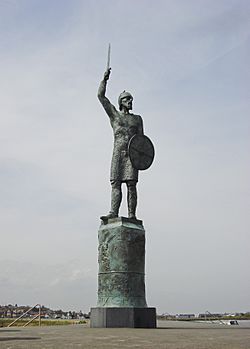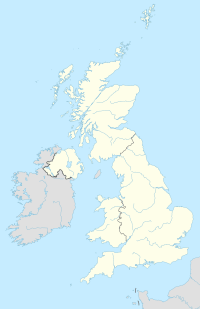Battle of Maldon facts for kids
Quick facts for kids Battle of Maldon |
|||||||
|---|---|---|---|---|---|---|---|
| Part of the Viking invasions of England | |||||||
 A statue of Byrhtnoth in Maldon, by John Doubleday |
|||||||
|
|||||||
| Belligerents | |||||||
| Anglo-Saxons | Norse Vikings | ||||||
| Commanders and leaders | |||||||
| Byrhtnoth † | Olaf, possibly Olaf Tryggvason | ||||||
| Strength | |||||||
| Unknown | 2,000–4,000 men | ||||||
| Casualties and losses | |||||||
| Unknown | Unknown | ||||||
The Battle of Maldon took place on 11 August 991 AD near Maldon beside the River Blackwater in Essex, England, during the reign of Æthelred the Unready. Earl Byrhtnoth and his thegns led the English against a Viking invasion. The battle ended in an Anglo-Saxon defeat. After the battle Archbishop Sigeric of Canterbury and the aldermen of the south-western provinces advised King Æthelred to buy off the Vikings rather than continue the armed struggle. The result was a payment of 10,000 Roman pounds (3,300 kg) of silver, the first example of Danegeld in England.
An account of the battle, embellished with many speeches attributed to the warriors and with other details, is related in an Old English poem which is usually named "The Battle of Maldon". A modern embroidery created for the millennium celebration in 1991 and, in part, depicting the battle, can be seen at the Maeldune Centre in Maldon.
One manuscript of the Anglo-Saxon Chronicle states that a certain Olaf, possibly the Norwegian Olaf Tryggvason, led the Viking forces, these estimated to have been between 2,000 and 4,000 fighting men. A source from the 12th century, Liber Eliensis, written by the monks at Ely, suggests that Byrhtnoth had only a few men to command: "he was neither shaken by the small number of his men, nor fearful of the multitude of the enemy". Not all sources indicate such a disparity in numbers.
The poem "The Battle of Maldon"
"The Battle of Maldon" is the name conventionally given to a surviving 325-line fragment of Old English poetry. Linguistic study has led to the conjecture that initially the complete poem was transmitted orally, then in a lost manuscript in the East Saxon dialect and now survives as a fragment in the West Saxon form, possibly that of a scribe active at the Monastery of Worcester late in the 11th century. It is fortuitous that this was attached at an early date to a very notable manuscript, Asser's Life of King Alfred, which undoubtedly assisted in its survival. The manuscript, by now detached, was burned in the Cotton library fire at Ashburnham House in 1731. The keeper of the collection, John Elphinstone (or his assistant, David Casley), had transcribed the 325 lines of the poem in 1724, but the front and back pages were already missing from the manuscript (possibly around 50 lines each): an earlier catalogue described it as fragmentum capite et calce mutilatum ('mutilated at head and heel'). As a result, vital clues about the purpose of the poem and perhaps its date have been lost.
At the time of battle, English royal policy of responding to Viking incursions was split. Some favoured paying off the Viking invaders with land and wealth, while others favoured fighting to the last man. The poem suggests that Byrhtnoth held this latter attitude, hence his moving speeches of patriotism.
The Vikings sailed up the Blackwater (then called the Panta), and Byrhtnoth called out his levy. The poem begins with him ordering his men to stand and to hold weapons. His troops, except for personal household guards, were local farmers and villagers of the Essex Fyrd militia. He ordered them to "send steed away and stride forwards": they arrived on horses but fought on foot. The Vikings sailed up to a small island in the river. At low tide, the river leaves a land bridge from this island to the shore; the description seems to have matched the Northey Island causeway at that time. This would place the site of the battle about two miles southeast of Maldon. Olaf addressed the Saxons, promising to sail away if he was paid with gold and armour from the lord. Byrhtnoth replied, "We will pay you with spear tips and sword blades."
With the ebb of the tide, Olaf's forces began an assault across the small land bridge. Three Anglo-Saxon warriors, Wulfstan, Ælfhere and Maccus blocked the bridge, successfully engaging any Vikings who pressed forward (lines 72-83). The Viking commander requested that Byrhtnoth allow his troops onto the shore for formal battle. Byrhtnoth, for his ofermōde (line 89b), let the enemy force cross to the mainland. Battle was joined, but an Englishman called Godrīc fled riding Byrhtnoth's horse. Godrīc's brothers Godwine and Godwīg followed him. Then many English fled, recognizing the horse and thinking that its rider was Byrhtnoth fleeing. To add insult to injury, it is stated that Godric had often been given horses by Byrhtnoth, a detail that, especially during the time period, would have had Godric marked as a coward and a traitor, something that could have easily been described as worse than death. The Vikings overcame the Saxons after losing many men, killing Byrhtnoth. After the battle Byrhtnoth's body was found with its head missing, but his gold-hilted sword was still with his body.
There is some discussion about the meaning of "ofermōd". Although literally meaning "over-heart" or "having too much heart", it could mean either "pride" or "excess of courage" (compare the Danish overmod or German Übermut, which mean both "hubris" and "recklessness"). One argument is that the poem was written to celebrate Byrhtnoth's actions and goad others into heroic action, and Byrhtnoth's action stands proudly in a long tradition of heroic literature. Another viewpoint, most notably held by J. R. R. Tolkien, is that the poem is an elegy on a terrible loss and that the monastic author pinpoints the cause of the defeat in the commander's sin of pride, a viewpoint bolstered by the fact that ofermōd is, in every other attested instance, used to describe Satan's pride. There is a memorial window, representing Byrhtnoth's dying prayer, in St Mary's church at Maldon.
It is believed by many scholars that the poem, while based upon actual events and people, was created to be less of a historical account and more of a means of enshrining and lifting up the memories of the men who fought and lost their lives on the battlefield protecting their homeland, especially in the case of the English commander of the battle, Byrhtnoth. He (Byrhtnoth) seems to embody many of the virtues that are uplifted in the Anglo-Saxon world, and is compared often by many scholars to the character Beowulf.
Norse invaders and Norse raiders differed in purpose. The forces engaged by the Anglo-Saxon were raiding, or (in Old Norse "í víking", to gather loot, rather than to occupy land for settlement. Therefore, if Byrhtnoth's forces had kept the Vikings off by guarding the causeway or by paying them off, Olaf would likely have sailed farther up the river or along the coast, and raided elsewhere. As a man with troops and weapons, it might be that Byrhtnoth had to allow the Vikings ashore to protect others. The poem may, therefore, represent the work of what has been termed the "monastic party" in Ethelred's court, which advocated a military response, rather than tribute, to all Norse attacks.
In modern fiction
- The Homecoming of Beorhtnoth Beorhthelm's Son is the title of a work by J. R. R. Tolkien that was originally published in 1953 in volume 6 of the scholarly journal Essays and Studies by Members of the English Association. It is a work of historical fiction, inspired by the Old English Maldon fragment. It is written in the form of an alliterative poem, but is also a drama, being mainly a dialogue between two characters in the aftermath of the Battle of Maldon. The work was accompanied by two essays, also by Tolkien, one before and one after the main work.
- At Maldon by J. O. Morgan is a book-length poem retelling the story of the Battle of Maldon in modern English.
- K.V. Johansen's short story "Anno Domini Nine Hundred and Ninety-One", in the collection The Storyteller and Other Tales is a retelling of the Battle of Maldon.
- In one episode of the science fiction novel Perelandra by C. S. Lewis, the protagonist (a philologist from Cambridge transported to the planet Venus) finds himself "shouting a line out of 'The Battle of Maldon'" as he fights the Un-Man, a demon-possessed scientist.
- The Swedish bestselling historical novel The Long Ships (Röde Orm) by Frans G. Bengtsson includes a long fictionalised account of the Battle of Maldon, described from the Scandinavian side.
- In David Drake's short story As Our Strength Lessens in Keith Laumer's Bolo series, a sentient tank named after the battle of Maldon discusses the battle with a human officer. They consider whether Byrhtnoth and his men acted nobly or failed in their mission to protect the land and people from the Viking invaders.
- The English black metal band Winterfylleth have two songs in their album The Ghost of Heritage (2008) that remembers the Battle of Maldon (track 2: "The March to Maldon" (03:46) and track 3: "Brithnoth: The Battle of Maldon (991 AD)" (7:38)).
- The Norwegian / German symphonic metal band Leaves' Eyes has a song called The Battle of Maldon on their 2009 EP, My Destiny.
- Essex actor and poet Ken Lodge wrote a tribute to Brithnoth entitled "Byrhtnoth's Return". The poem appeared on Maldon's Historic Facebook page in April 2017.
Images for kids
See also
 In Spanish: Batalla de Maldon para niños
In Spanish: Batalla de Maldon para niños



